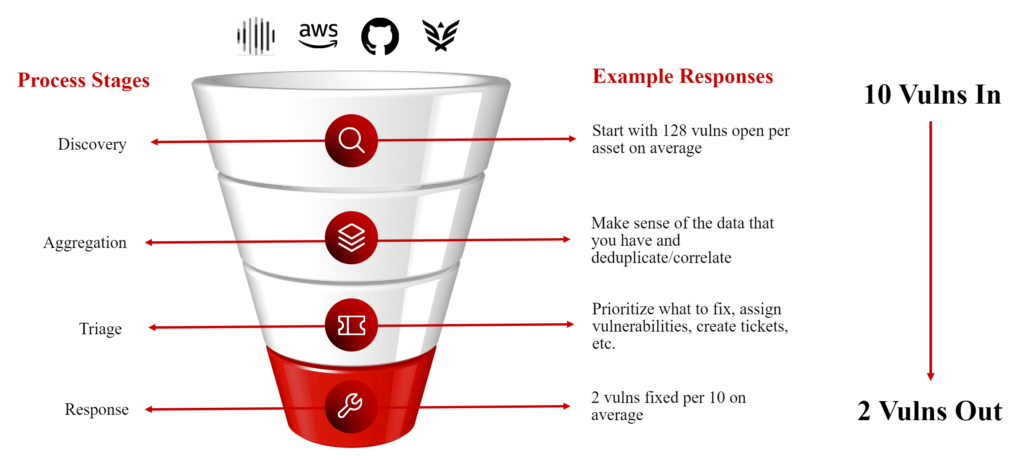How Security Debt Compounds Vulnerability Risk

Organizations often find themselves caught in a perpetual cycle of identifying, prioritizing, and mitigating vulnerabilities that pose the most risk. Amid this ongoing battle, a significant challenge is often overlooked: security debt. Much like technical debt, security debt refers to the accumulation of unresolved vulnerabilities within an organization’s systems and software. Over time, the accumulation of lower priority vulnerabilities grows, making it increasingly difficult—and sometimes nearly impossible—to defend against attacks effectively.
During the recent Fal.Con conference, Nucleus COO Scott Kuffer hosted a session about how risk-based vulnerability management is increasing organizations’ security debt. The premise is that the focus on remediating high priority vulnerabilities creates a greater backlog of ‘lower’ risk vulnerabilities which, over time, seriously taxes the organization’s resources and security.
Through the standard phases of discovery, aggregation, triage, and response, organizations may end up only remediating two vulnerabilities out of every 10, on average. The remaining 80% of unresolved vulnerabilities still pose some level of threat but continue to get pushed back further as new ‘critical’ vulnerabilities are discovered.

For vulnerability management teams, the compounding nature of security debt can transform routine remediation activities into an insurmountable challenge. It can also have a demonstrable effect on the company’s bottom line, making it a topic of interest for every department across the organization.
The Impact of Security Debt on Organizations
Security debt doesn’t happen overnight. It’s the result of delayed patching, postponed upgrades, incomplete security implementations, and the persistent presence of known vulnerabilities. Risk-based remediation, as we’ve seen, can make the backlog worse. When an organization repeatedly pushes lower priority security tasks to the back burner, it accrues security debt that can have several adverse effects:
- Increased Attack Surface: As security debt accumulates, it broadens the attack surface by leaving more vulnerabilities exposed. Attackers can exploit these known weak points to infiltrate systems, often with devastating consequences.
- Complex Remediation: The more security debt an organization carries, the more complex remediation efforts become. Dependencies between systems grow tangled, making it difficult to patch one vulnerability without affecting others. This complexity can lead to hesitation and delay in addressing critical issues.
- Resource Drain: Managing and mitigating security debt can become an exhaustive drain on resources. Security teams may find themselves in a constant state of firefighting, unable to focus on proactive measures due to the sheer volume of existing vulnerabilities.
- Compliance Risks: Many industries are governed by strict compliance regulations that require prompt vulnerability remediation. Accumulated security debt can lead to non-compliance, resulting in fines, legal repercussions, and damage to the organization’s reputation.
- Decreased Resilience: The more debt an organization carries, the less resilient it becomes to new threats. New vulnerabilities continue to emerge, and if an organization is already burdened with significant security debt, it will struggle to keep up with the evolving threat landscape.
Understanding the compounding nature of security debt is crucial. Much like interest on a financial loan, unaddressed security vulnerabilities grow more problematic and costly over time. If left unchecked, security debt can reach a tipping point where it becomes almost impossible to manage effectively, leaving organizations exposed to severe risks.
Expedited vs. Efficient – The Vulnerability Remediation Dilemma
Risk-based vulnerability management and remediation was meant to be a strategy that put the emphasis on remediating the highest risk vulnerabilities immediately. While it remains a necessity to resolve those vulnerabilities most likely to become serious breaches, expedited remediation can’t be an organization’s only approach.
Beyond creating increased security debt, the focus on expedited remediation only creates a strain between security and IT teams within the organization. Security teams will very often overwhelm IT with remediation tickets if they don’t have another means of handling what might otherwise be rated a lower-risk vulnerability.
We’ve seen some of our customers institute a second layer to their vulnerability remediation strategy: efficient remediation. We called the choice between expedited and efficient a dilemma, but it really presents an opportunity for Security and IT to work in conjunction and alleviate their security debt together.
An effective remediation strategy involves giving IT and Dev teams visibility into vulnerability scoring, allowing them to see and evaluate the vulnerability backlog as part of their regular sprints or other development lifecycles. They can then make decisions about resources, assigning remediation properly to their SLAs and patch windows to efficiently manage and reduce the number of existing vulnerabilities.
On the Security team’s side, they can focus on identifying and ticketing only the most pressing vulnerabilities as critical. This side-by-side approach allows each team to work to its strengths and eliminates the resentment and division that comes from “lobbing tickets over the fence.”
Security Debt Is Real but Solvable
As organizations face newly discovered vulnerabilities, their security debt will inevitably deepen. This can have long-term effects on the ability to defend against attacks and keep critical data secure. Risk-based vulnerability management strategies, while designed to help prioritize and make security more efficient, have unintentionally contributed to the issue.
By recognizing the challenges presented by security debt, employing a side-by-side approach to remediating both critical and other vulnerabilities, and employing the Nucleus platform’s risk scoring, vulnerability intelligence, and business context, organizations can begin to turn the tide, reducing both their security debt and exposure to potential attacks.
See Nucleus in Action
Discover how unified, risk-based automation can transform your vulnerability management.






























